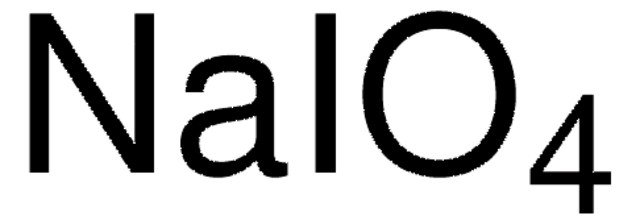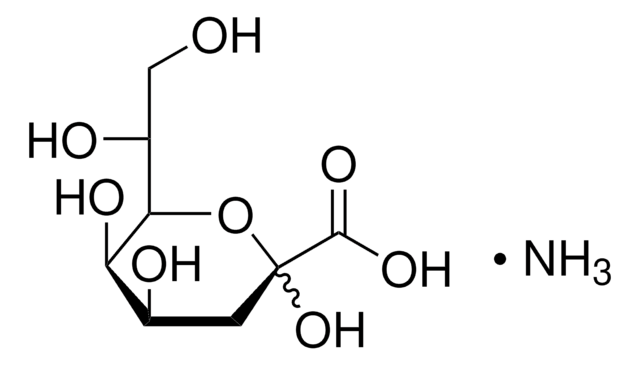Key Documents
311448
Sodium periodate
ACS reagent, ≥99.8%
Synonim(y):
Sodium (meta)periodate
About This Item
Polecane produkty
klasa czystości
ACS reagent
Poziom jakości
Próba
≥99.8%
99.8-100.3% dry basis (ACS specification)
Postać
crystalline powder
przydatność reakcji
reagent type: oxidant
zanieczyszczenia
≤0.02% other halogens (as Cl)
pH
3.5-5.5 (25 °C, 107 g/L)
mp
300 °C (dec.) (lit.)
ślady kationów
Mn: ≤3 ppm
temp. przechowywania
room temp
ciąg SMILES
[Na+].[O-]I(=O)(=O)=O
InChI
1S/HIO4.Na/c2-1(3,4)5;/h(H,2,3,4,5);/q;+1/p-1
Klucz InChI
JQWHASGSAFIOCM-UHFFFAOYSA-M
Szukasz podobnych produktów? Odwiedź Przewodnik dotyczący porównywania produktów
Opis ogólny
Zastosowanie
- In the selective oxidation of sulfides to sulfoxides.
- For the oxidative cleavage of a variety of 1,2-diols to generate aldehydes or ketones.
- In the oxidation of diaryl, dialkyl, and aryl alkyl selenides to the respective selenoxides.
- In the selective alkene epoxidation and alkane hydroxylation reactions.
- In the selective oxidation of activated cellulose to obtain dialdehyde cellulose (DAC) by cleavage of the bond between C2 – C3 in the glucose unit.
- It can also be used as an iodinating agent for the iodination of arenes and halo compounds.
Hasło ostrzegawcze
Danger
Zwroty wskazujące rodzaj zagrożenia
Zwroty wskazujące środki ostrożności
Klasyfikacja zagrożeń
Aquatic Acute 1 - Aquatic Chronic 1 - Eye Dam. 1 - Ox. Sol. 1 - Skin Corr. 1C - STOT RE 1
Organy docelowe
Thyroid
Kod klasy składowania
5.1A - Strongly oxidizing hazardous materials
Klasa zagrożenia wodnego (WGK)
WGK 3
Temperatura zapłonu (°F)
Not applicable
Temperatura zapłonu (°C)
Not applicable
Certyfikaty analizy (CoA)
Poszukaj Certyfikaty analizy (CoA), wpisując numer partii/serii produktów. Numery serii i partii można znaleźć na etykiecie produktu po słowach „seria” lub „partia”.
Masz już ten produkt?
Dokumenty związane z niedawno zakupionymi produktami zostały zamieszczone w Bibliotece dokumentów.
Klienci oglądali również te produkty
Nasz zespół naukowców ma doświadczenie we wszystkich obszarach badań, w tym w naukach przyrodniczych, materiałoznawstwie, syntezie chemicznej, chromatografii, analityce i wielu innych dziedzinach.
Skontaktuj się z zespołem ds. pomocy technicznej











